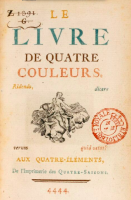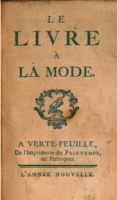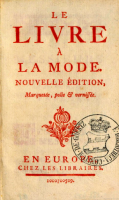
Louis-Antoine Caraccioli strove endlessly to appeal to the ‘tastes of the age’ in his writing. As a moralist publishing in the mid-eighteenth century, he had an uphill battle. His subject matter was, more often than not, outmoded. He frequently condemned the libertine behaviours of his contemporaries, and evoked seventeenth-century philosophies with nostalgia, lamenting the advent of the Enlightenment philosophes. Yet Caraccioli, a former clergyman descended from a ruined branch of the illustrious Neapolitan House of Caracciolo, had to make a living. He tried to do so by the pen. To appeal to a readership, he produced books aimed to please, broaching popular themes like la jouissance – pleasure – and sociability. He promoted the centrality of reason to religious practice, reconciling Enlightenment philosophies with Catholic doctrine. By far the most striking of his works are three short texts published in 1759 and 1760 – Le Livre à la mode à verte feuille, La Livre à la mode nouvelle édition, and Le Livre de quatre couleurs.

Clothed in the garments of coloured ink, these works are, quite literally, à la mode – fashionable. The first is printed entirely in green, the second in pink, and the third, unsurprisingly, in four colours – red, blue, yellow, and brown. ‘Should a century so pretty as ours write in black characters, which resemble catafalques and burials?’[1] Caraccioli asks in the preface to the first. Of course not. Authors, he suggests, should produce books which correspond to their readers. There is a clear commercial strategy at play here. Through visual appeal, Caraccioli sought to seduce an urbane public and, ultimately, to make money. Were these books simply a way for their author to boost his sales? A closer look at the specific role(s) played by colour in the works reveals a rather more complex picture.
The first thing to note is that, at least initially, the works were a failure. Le Livre à la mode (vert) received a scathing review from the Année littéraire, a periodical which usually regarded Caraccioli favourably: ‘This supposedly fashionable book has never been so.’[2] The critic saw through the work’s verdant veil, focusing on the critique at the heart of its content. Each of the three books presents a satire of eighteenth-century French society. They depict frivolous characters engaged in whimsical activities. Petits-maîtres, precursors to nineteenth-century fops or dandies, feature prominently. They spend hours preening themselves at their toilette each day, before parading through town like peacocks on display or, in yet another avian motif, ‘parroting’ one another’s style. Caraccioli was certainly not the only author to present caricatured descriptions of his peers. For the Année littéraire, any novelty in the work’s appearance is overshadowed by its apparent jumble of trite stereotypes.

One year later, the same journal published a more positive review of Le Livre de quatre couleurs, praising Caraccioli for his levity and wit.[3] Visually, this book is even more impressive than its predecessors. To print not one but several colours onto a single page (as the title page does) required significant skill and precision, not to mention financial investment. Like the two Livres à la mode, Le Livre de quatre couleurs is satirical. It concludes with the final ‘testament’ of the ‘Grand petit-maître of the Order of Frivolity’, for example. The work’s Latin epigraph, spread ludically across its title page, is adapted from Horace’s Satires. Translated, it reads: ‘What prevents a person from speaking the truth by means of smiling?’ Versions of this phrase were commonplace in eighteenth-century didactic literature which united pleasure to instruction. What makes this instance notable is the fact that the ‘smile’ instrumentalised by Caraccioli is twofold: verbal wit is complemented here by whimsical appearance. Literary satire becomes illustrative; characters are not only described but depicted. The texts’ colourful image was a way of giving readers what they wanted. Parisian petits-maîtres rejoice in Le Livre à la mode (rose) because the city is filled with thousands of mirrors, reflecting their likeness at every turn. So, Caraccioli creates a book which is ‘dressed’ and ‘made-up’ to resemble its readership.

The book’s visual satire is exemplified in a further metaphor: that of the ‘magic lantern’, through which Caraccioli claims readers wish to see the world.[4] Magic lantern operators would shine candlelight through a series of lenses to project images of exotic landscapes, or anatomical diagrams onto walls, creating marvellous spectacles designed to teach as much as to enthral audiences. By ‘projecting’ a visual representation of readers and their behaviours in his text, Caraccioli amuses them, but also seeks to instruct. In seeing themselves caricatured upon the pages of the work, readers, it is implied, may be spurred to change.
The kaleidoscopic trio is a curious literary artefact which can illuminate the innovative ways in which authors engaged with the eighteenth-century literary market. They give rise to a number of contradictions, which I will outline by way of conclusion. The first is that while claiming to be fashionable, the first of these works fell short. Despite his best efforts, Caraccioli showed himself to be behind the time. Of course fashion is, by nature, transient so the works are always necessarily unstable. Indeed, the narrator of Le Livre à la mode (pink) claims the book will endure only an hour and twenty minutes at best. Here we encounter the second contradiction. While evoking ephemerality, these texts are some of the most enduring in Caraccioli’s corpus, and continue to fascinate scholars today. A third, and final, contradiction comes in the picture these works paint of Caraccioli himself. In satirising his peers, the author reveals an intimate and detailed knowledge of their whimsical pursuits. He is not distanced from the urbane world he depicts, but rather is fully immersed in it. The mirror Caraccioli holds up to his readers may well be held up also to himself. By indulging readers’ desires for books which ‘suit’ them, the author inaugurates a ‘rococo moralism’, showing himself to be less a nostalgic reactionary, and rather wholly of his time.
[1] Louis-Antoine Caraccioli. Le Livre à la mode à verte feuille (De l'Imprimerie du Printemps, au Perroquet, 1759), p. vii. All translations are my own.
[2] Elie-Cathérine Fréron ed., L’Année littéraire, t. 3, (Amsterdam: Lambert, 1759), p. 258.
[3] Ibid., (Amsterdam: Lambert, 1760), p. 217.
[4] Caraccioli, Livre à la mode nouvelle édition (Europe, chez les libraires, 1759), p. xxix.